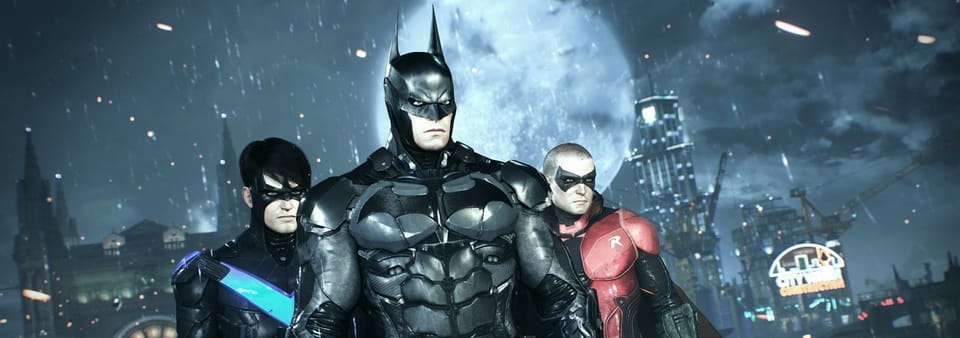Gotham City Burning

This article was written by Jorge Albor and originally published on Pop Matters. For more of his writing, check the site here.
It was brought to us by our friends at Critical Distance, who find the best in critical writing about games each week. You can see more at their site, and support them on Patreon.
///
What does Gotham city mean to you? I have been asking myself this question lately as I play through Batman: Arkham Knight. I spend most of my time gliding around from above, doing my best to avoid boring vehicle gameplay, so I guess Gotham city is its skyscrapers. Or maybe Gotham is the ant-like swarm of enemies populating its streets in endless supply. Or maybe its villains, who have seemingly agreed to carve up the city into their own bite-size portions of malevolence. I suspect all of these are unsatisfying answers.
A sense of place, that ephemeral subjective quality, can be so hard to describe. It shifts and blurs, a combination of emotions, history, politics, and geography. A sense of place can be, at the same time, personal yet collective. For example, I know what Northern California means to me. It is rocky shorelines, vineyards, redwoods, day laborers, and tired hands, among other things. I struggle to understand Gotham city with the same clarity. Why is that?
Driving from Sacramento to Los Angeles, along the I5, you’ll get a lengthy glimpse of the Central Valley that dominates much of the state’s topography. Huge tracts of farmland and desert will make you forget California as a place of scenic shorelines and surf bums. Strawberries, lettuce, almonds, artichokes, you’ll pass fields of them all. There is bounty, even as agriculture consumes eighty percent of California’s dought-stricken water supply, and faded signs along the freeway remind you of the politics that define California.

There must be a place for politics in our media. Roman Polanski’s Chinatown taps into the politics of the California Water Wars to give you a spectral view of California, and Los Angeles in particular. In one scene, an L.A. aqueduct is a parched and desolate extension of the city. It feels like a ghost town, not a paradise. In another, our antihero is literally drowning in a sudden flood of water that, like a prop in some magic trick, comes and goes without a trace. In Chinatown, and reality, Los Angeles, and by extension California, hides something below its arid dirt. California is a place where power and water flow the same direction.
A sense of place, that ephemeral subjective quality, can be so hard to describe
There is truth to this image of California. This is why it seems I am more forgiving than others on this season of True Detective. The California of HBO’s cop drama is dry, ugly, and fueled by immigrant labor and industry. The frequent interstitials of California freeways display California as a place of movement, flows of people and goods pumping through the veins of California across almost alien landscapes. It is a place hard to understand, but that nevertheless pushes onward. Likewise, the film Inherent Vice buzzes with the same indecipherable quality of California. If you are from here, you can sense a piece of it in these shows and films.

See, California is all these things and more. It is a perceived myth as much as anything else. As Joan Didion puts it in Slouching Towards Bethlehem, California is a place where “the mind is troubled by some buried but ineradicable suspicion that things better work here, because here, beneath the immense bleached sky, is where we run out of continent.” Place as politically-infused concept should be felt even in our cultural artifacts. I find her image of Los Angeles an especially powerful example:
The city burning is Los Angeles’s deepest image of itself: Nathanael West perceived that in The Day of the Locust; and at the time of the 1965 Watts riots what struck the imagination most indelibly were the fires. For days one could drive the Harbor Freeway and see the city on fire, just as we had always known it would be in the end.

Gotham is burning in Arkham Knight, but what kindles its fires? Batman protects “Gotham’s money” from Two-face and his gang, but from where does that money flow? The Penguin smuggles in guns, but to what end? Chinatown is a major landmark, but a city devoid of citizens is a city without its defining racial politics. Bruce Wayne warns Poison Ivy that without her help, every plant in the city will die, but where are Gotham’s parks? In daylight, would we find that sense of place missing from the empty roads and sidewalks?
What is California? It is the quiet valley, the oppression of drought, the politics of race in Los Angeles, the unspoken place of indigenous peoples; it is the hills on fire. What is Gotham City? It is a simplified movie set and I am a tired actor.
///
This article was written by Jorge Albor and originally published on Pop Matters. For more of his writing, check the site here.
It was brought to us by our friends at Critical Distance, who find the best in critical writing about games each week. You can see more at their site, and support them on Patreon.



